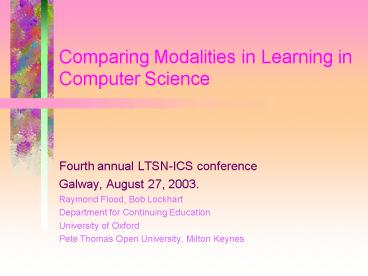Comparing Modalities in Learning in Computer Science - PowerPoint PPT Presentation
1 / 16
Title:
Comparing Modalities in Learning in Computer Science
Description:
University of Oxford. Pete Thomas Open University, Milton Keynes. 2 ... courses, on the basis of a questionnaire much used within Oxford University. ... – PowerPoint PPT presentation
Number of Views:47
Avg rating:3.0/5.0
Title: Comparing Modalities in Learning in Computer Science
1
Comparing Modalities in Learning in Computer
Science
- Fourth annual LTSN-ICS conference
- Galway, August 27, 2003.
- Raymond Flood, Bob Lockhart
- Department for Continuing Education
- University of Oxford
- Pete Thomas Open University, Milton Keynes
2
One course - two delivery modes
- Undergraduate diploma in computing.
- Part time study over two years.
- 120 CATS points at level two.
- Twelve topics - basic undergraduate computer
science. - Continuous assessment plus an annual examination.
- No formal admission requirements.
3
Class course
- Two-hour lecture weekly - October to May.
- Three weekend schools each year.
- One exam each year, in June.
- Single class of 15-20 students.
- Variety of lecturers.
- Possession of a computer is not essential.
- Limited amount of hands-on computing.
4
Class course, Internet course.
- Two-hour lecture weekly - October to May.
- Three weekend schools each year.
- One exam each year, in June.
- Single class of 15-20 students.
- Variety of lecturers.
- Possession of a computer is not essential.
- Limited amount of hands-on computing.
- Units last six weeks and are delivered via Web.
- One, six-day, summer school each year.
- One exam each year, in August.
- Classes of 100-150 students.
- Students are in tutor groups of 15-20 students.
- Internet connection vital.
- Some hands-on computing.
5
The versions of this course are similar in .
- Subject matter.
- Teaching staff.
- Assignments.
- Examinations.
6
The versions of this course are different in .
- Delivery modes.
- Timing.
- Support.
- Size.
- Facilities.
7
The point of this work is .
- To compare student performance in the two
courses, on the basis of assessment results. - To compare the students perceptions of their
educational experience of these courses, on the
basis of a questionnaire much used within Oxford
University.
8
Axiomatics
- We believe the courses are sufficiently similar
in subject matter and assessment for us to relate
differences in performance and perception to the
different delivery modes. - Of course, there are differences in the two
modes. - And it may well be that they attract different
sorts of students in the first place or that
different sorts of students do well in them. - We do have stable courses - both courses have
been running for more than four years.
9
Demographics
- The mean age of class-based students is usually a
little above that of the Internet students. - Both courses attract students with average age
just above 35. - A bigger proportion of the class course is
usually female (sometimes more than 50). - In the Internet course we normally have about 65
male students. - Attrition rates are much lower in the class
course.
10
Assessed performance
- The figures support the view that students
completing these courses perform as well in
either version. - This applies both to continuous assessment and
examination scores. - There was a significant difference in the first
cohort of Internet students. - They performed significantly better in the
examinations. - This may be a phenomenon anecdotally observed in
the OU - the first cohort does better! - This certainly has not occurred in subsequent
years.
11
Typical results
12
Student perceptions
- We used a questionnaire developed by IAUL,
Oxford, and previously administered to just under
one thousand Oxford undergraduates. - The questionnaire involves about 70 questions,
most involving a five-point Lickert scale.
13
Questionnaire results
- Internet students tended to hold stronger
opinions all round! - Clear difference in appreciation of team-building
skills from Internet students. - This may relate to structural differences between
the two courses. - We are considering how we might introduce more
group working into the house course due to this
response.
14
Further work
- We have much additional material to analyse.
- This includes the performance and opinions of
further cohorts of students. - Plus additional feedback from standard
departmental questionnaires. - We should also like to target particular
questions suggested by this work.
15
Further questions
- Can attrition in the Internet course be related
to delivery modes? - Does attrition correlate with various sorts of
support? - Should we consider re-organising some aspect of
support and delivery? - Would the inclusion of some aspects of the
Internet course augment the house course?
16
Further information
- More detailed information is included in our
paper. - We have also started work on a Web site
www.conted.ox.ac.uk/cleat where more information
may be found.
Thank You!































